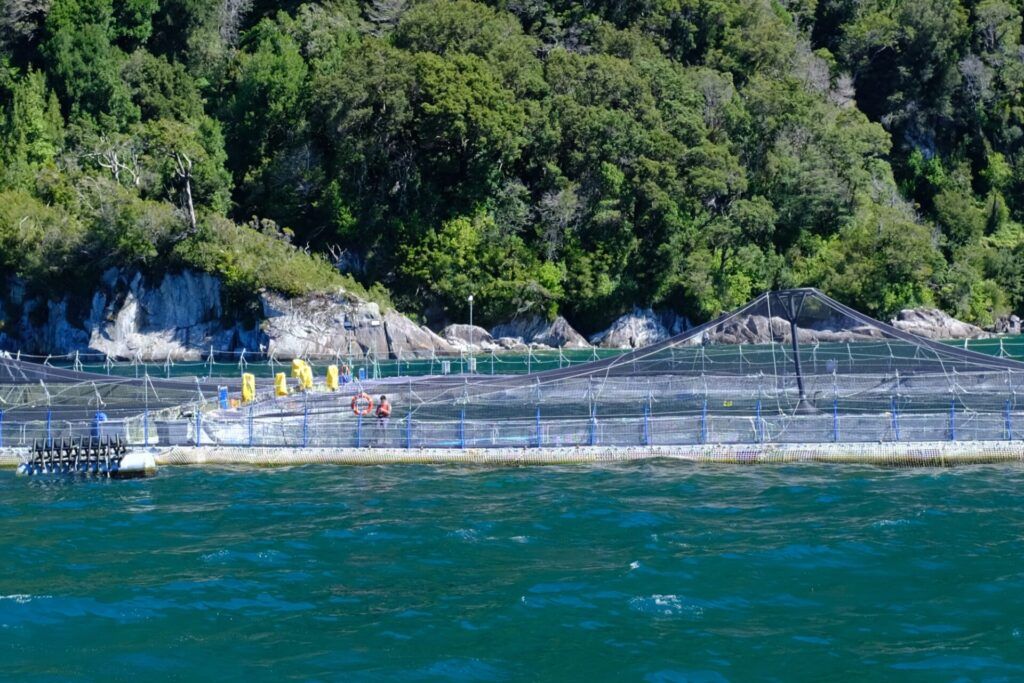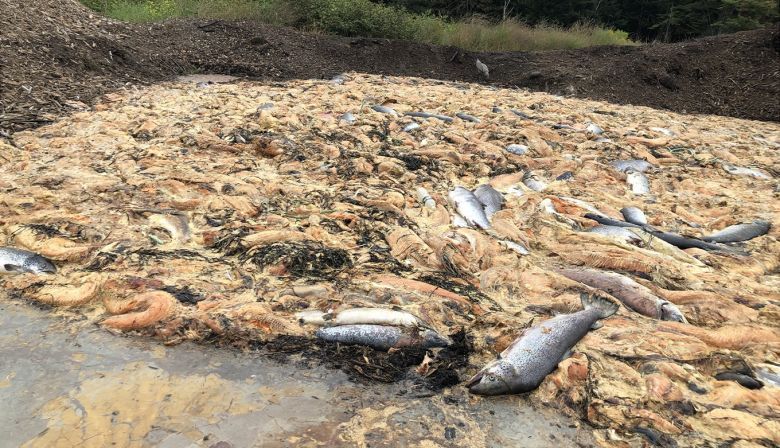When maximizing food production manufactures disaster risk
By Charlie Mather, Gerald Singh | October 30, 2024
 A salmon farm in Chile. Since 2004, 44 divers have died while working on Chilean salmon farms.(Photo: Jessica McKenzie)
A salmon farm in Chile. Since 2004, 44 divers have died while working on Chilean salmon farms.(Photo: Jessica McKenzie)
The “perfect storm” is a phrase often invoked to suggest a combination of rare events that generate something unusually large and adverse. Often used in meteorological contexts, “perfect storms” highlight the rise of multiple factors that create natural hazards of considerable size, such as floods, hurricanes, and other natural disasters. The term is also used metaphorically to describe the conditions that give rise to industrial disasters, such as chemical leaks, oil spills, and mining disasters. However, as warned by early cyberneticists Arturo Rosenblueth and Norbert Wiener, “the price of metaphor is eternal vigilance.”
While the storm metaphor is effective in talking about multiple causes, it also gives the impression that the causes of disasters are natural and beyond our control. However, investigations into major disaster events show that they are rarely caused by natural forces alone. Instead, this scholarship argues that disasters are the result of risks that are “manufactured” through a combination of human decision making and natural events. This so-called manufactured risk is the result of industrial processes that prioritize efficiency and perpetual economic growth in weak regulatory contexts. There is increasing evidence that disaster events are affecting our food systems, and we suggest that it is because of manufactured risk.
Some of the largest industrial disasters in history were presented by their companies as surprises, but retrospective analyses showed the distasters to be predictable or even inevitable. The Bhopal chemical disaster in India in 1984, which killed thousands and impacted over half a million people, was one such case. Recent work has shown that some of the factors that led to the failures at Bhopal are shared with a wide range of other industrial disasters such as the Deepwater Horizon oil spill in 2010 in the Gulf of Mexico and the Fukushima nuclear disaster in 2011 in Japan. The concept of manufactured risk points to disasters being the result of a complex set of causes that involve companies attempting to maximize growth and profits—often in response to shareholder pressure—which leads to lapses in safety, while actively hiding the extent of problems.
In some contexts, a weak regulatory environment allowed companies to embark on risky practices. For example, some suggest that the chemical plant in Bhopal was built by Union Carbide with a neglect of safety partly because of its location, as the local government and region pervasive with poverty would be less likely to require and enforce safety standards, compared to a comparable chemical plant that Union Carbide built in West Virginia. But while the regulatory context (or lack thereof) can allow companies to cut corners, there are further factors that contribute to companies and organizations taking riskier actions. Efforts to optimize production to the limits of what’s achievable (and profitable) have pushed companies to increasingly build production sites in riskier contexts, such as drilling for oil in deeper sites further offshore, exposing oil platforms to intense storms. Mining the ocean floor is yet another example of companies pushing to extract resources in increasingly risky contexts.
While new technologies and practices are often seen as a way of reducing risk, they may backfire if they encourage riskier decisions and actions under a guise of a sense of safety. For example, “early warning systems”—data tools and assessments alerting industries if disaster predictors are present—can be part of a larger risk-management system but can also provide a sense of security and be used as a justification to take greater risks. Insights into the manufacturing of risk have been gained over decades of research into industrial and disaster contexts, but we suggest that a similar lens can increasingly be brought to food systems.
Since World War II, food systems have become increasingly industrialized. Food production still depends on natural processes, but it has become much more reliant on external manufactured inputs including chemical fertilizers, pesticides, and herbicides. These chemical inputs have become especially important in systems that are increasingly large scale, production intensive, and focused on monocropping. In other words, the intensity of production and the focus on one crop has led to a greater dependence on external chemical inputs.
By focusing on intensive production practices that yield more food for any given farm or production site, industrialized food systems have generated massive surpluses of grains, oilseeds, and fruits and vegetables. Indeed, food production has far outstripped population growth, which has doubled in the last 50 years. In animal agriculture, similar patterns are evident: Producers depend on antibiotics and growth hormones that are used in production systems that are very large and more concentrated. The industrialization of food has occurred mainly on land, but the farming of fish in the ocean has developed rapidly and farmed fish production recently surpassed wild caught fish harvest volumes. While these production gains have far outstripped population growth, they may be as vulnerable as industrial systems to the problem of manufactured risk.
Facilitating this scaling up of industrial food production on land and in the water are the scientific and technical tools used to promote them, in terms of technological development, genetics, inputs, and physiological limits of crops, livestock, and harvest species. Much attention in sustainability circles is placed on the industrial process of increased efficiency of output, and reducing the inputs needed to produce food. A focus on production efficiencies can simultaneously claim to address concerns of feeding the world and the profitability of food production companies, but it neglects the fact that currently food security issues are problems of food distribution and access. If pushing food productivity generates more food-related production disasters, this will only add to the distributional and equity concerns of food systems, with rural communities facing increased risk.
Indeed, there is evidence to suggest that industrialized food systems are becoming increasingly vulnerable to new and worsening disasters that have disproportionate local effects. Monocropping of grains and oilseeds has made farms vulnerable to pests that are now resistant to chemical treatments. They are also more vulnerable to natural events like droughts, warmer temperatures associated with climate change, and above average rainfall. The manufacturing of risk is especially evident in animal agriculture, where large production systems are facing disease challenges that lead to mass mortality events. These have obvious welfare implications but also significant consequences for the workers and communities that support these production systems. Large scale producers often promote their systems as “biosecure” in the face of disease threats like avian influenza, but there is strong evidence to show that diseases are amplified in production systems that confine hundreds of thousands of animals in small spaces.
Increasingly in industrial contexts, the owners of food production sites are separated from the people who produce the food and who are most impacted by disaster events. New ventures and approaches to food production, such as vertical farming, in which farming is done inside buildings requiring highly controlled settings, may introduce even more potential for disaster. A single missed input (a water or light system failure, for example) could result in enormous losses. Facing the consequences of disaster events, growers and the communities they are part of can face loss of income from production losses, but also regulatory reprisals and suspended production licenses. They also have to contend with cleaning up carcasses and other side effects.

New research showing the scale and frequency of disaster events in food systems raises questions about producers’ ability to forecast how much systems can take and the tendency to push up to those boundaries. For example, losses and culls in poultry farms because of zoonotic diseases (diseases that can transmit from animals to humans) such as avian influenza have generated global concerns.
To add to this understanding of risk in food systems, we have recently published research documenting the increase in the frequency and scale of mortality events in salmon aquaculture. We argue this can be understood as a problem of manufactured risk in food systems. We show that in most major salmon producing nations over the past decade, there has been an increase in how often the worst mortality events occur, and how many fish died per event. Related work has shown that the causes of these events is varied and involves a variety of environmental, dietary, and management factors. However, the same kinds of pressures that manufacture risk in chemical, nuclear, and oil settings are also present in salmon aquaculture production, which may in part explain the growth of these mass mortality events and may lead to future increases still.
Salmon aquaculture is continuing to push the biophysical boundaries of production. By continuing to expand salmon biomass production into new sites, aquaculture is moving into more open water environments, exposing fish to more intense and variable environmental conditions. Climate change is also making existing sites more environmentally hazardous. Beyond the choice of where salmon is produced, specific management decisions intended to decrease stress on salmons can backfire in highly variable environments. For example, during high temperature events when fish metabolism is boosted, giving fish chemical or mechanical delousing treatments (intended to free salmon from the stressors of parasitic sea lice) can actually cause widespread fish mortality, since the delousing treatment also increases metabolic demands.
Future promises to introduce “precision farming” of fish using technology to automate and optimize management decisions are aimed at increasing production in the context of increasingly variable environments. But they may instead introduce new opportunities for disasters, especially if they provide a false sense of security for producers to develop aquaculture sites in increasingly risky contexts. For example, efforts to produce salmon in land-based, indoor tanks may contain the consequences of salmon mortalities, but since they need to control every variable of production and can introduce cascading fail-points, may lead to increased rates of mass mortalities.
Multiple recorded mass mortality events have led to record losses of fish but also had significant impacts on the people tasked with cleaning them up. In 2016, 126,225 salmon died in just 26 minutes at a single fish farm in Norway from exposure to hydrogen peroxide used in pest treatment. In 2016, approximately 26 million salmon died from red algae in Chile; the total biomass loss could have filled 14 Olympic-sized swimming pools. The event also caused mass die-offs of shellfish and wild fish. In Newfoundland, Canada, a single event in 2019 led to the loss of 2.6 million fish, which was blamed on high water temperature and low dissolved oxygen. That same year, over 8 million fish died across farms in Norway, which the industry blamed on harmful algal blooms.
Cleaning up these disasters has stretched the on-site workforces (including divers and other fish handlers) to long hours and fatigue and increased exposure to toxic chemicals (such as hydrogen sulfide) from decomposing fish. In the Canadian case, cleanup required the temporary recruitment of fishers to help haul out carcasses, raising questions about the suitability and risk of using untrained workers and vessels not designed for handling these clean ups. In Norway, salmon aquaculture is ranked the second most hazardous industry after wild fisheries because of high occupational injury and fatality rates. Since 2004, 44 divers have died while working on Chilean salmon farms.
Like many industrial settings, food systems are also cases in which decision-making is often removed from the on-the-ground consequences. Sometimes, as is the case in many jurisdictions of salmon aquaculture, companies are insured against losses and lack government regulations against risk. These contexts can allow hyper-competitive markets of food production without regulatory checks and thereby encourage risky production. The adverse consequences of disasters fall on communities that may have had little to no input in the decisions.
Being wary of the creation of new food system disaster opportunities should create new investigations into limits of production, our tendency to push against these boundaries, and the equity consequences we create when we approach food security concerns through increased production rather than redistribution. To limit disaster, societies may need to understand that disasters always have a human component and are not rare perfect storms of unpredictable chance.
Together, we make the world safer.
The Bulletin elevates expert voices above the noise. But as an independent nonprofit organization, our operations depend on the support of readers like you. Help us continue to deliver quality journalism that holds leaders accountable. Your support of our work at any level is important. In return, we promise our coverage will be understandable, influential, vigilant, solution-oriented, and fair-minded. Together we can make a difference.
















